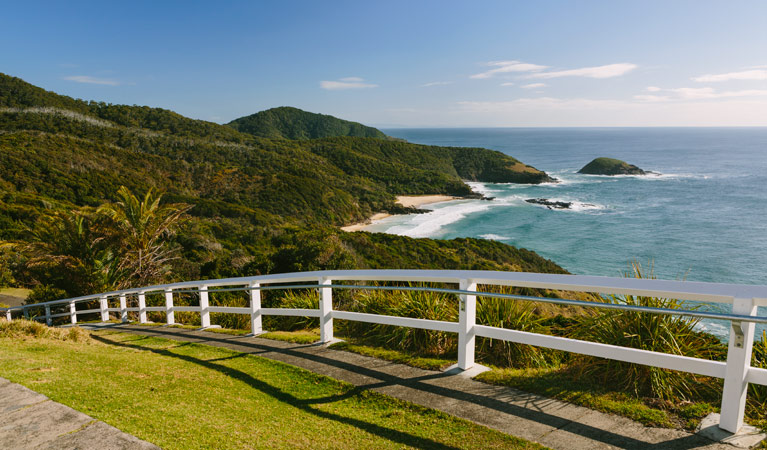Hat Head National Park
Overview
Hat Head National Park on the mid-north coast of NSW near South West Rocks is a natural paradise. Explore the lighthouse, camp by the beach and go fishing and swimming.
Read more about Hat Head National Park
Hat Head National Park, near Kempsey, is a place of exceptional beauty. The beaches, sand dunes, rainforest and wetlands offer an ideal backdrop for bushwalking, camping or a quiet picnic.
There is a choice of campgrounds, including campsites right by the beach, or you could stay at the Smoky Cape lighthouse keepers’ cottage with its stunning coastal views, be sure to take a guided tour.
There are lots of walking tracks to choose from, excellent fishing and whale watching. Birdwatchers can look for black swans and spoonbills in the park’s wetlands, hawks and eagles soaring above beach cliffs and shorebirds like curlews and plovers around the beach.
Local alerts
For the latest updates on fires, closures and other alerts in this area, see https://www.nationalparks.nsw.gov.au/visit-a-park/parks/hat-head-national-park/local-alerts
Map
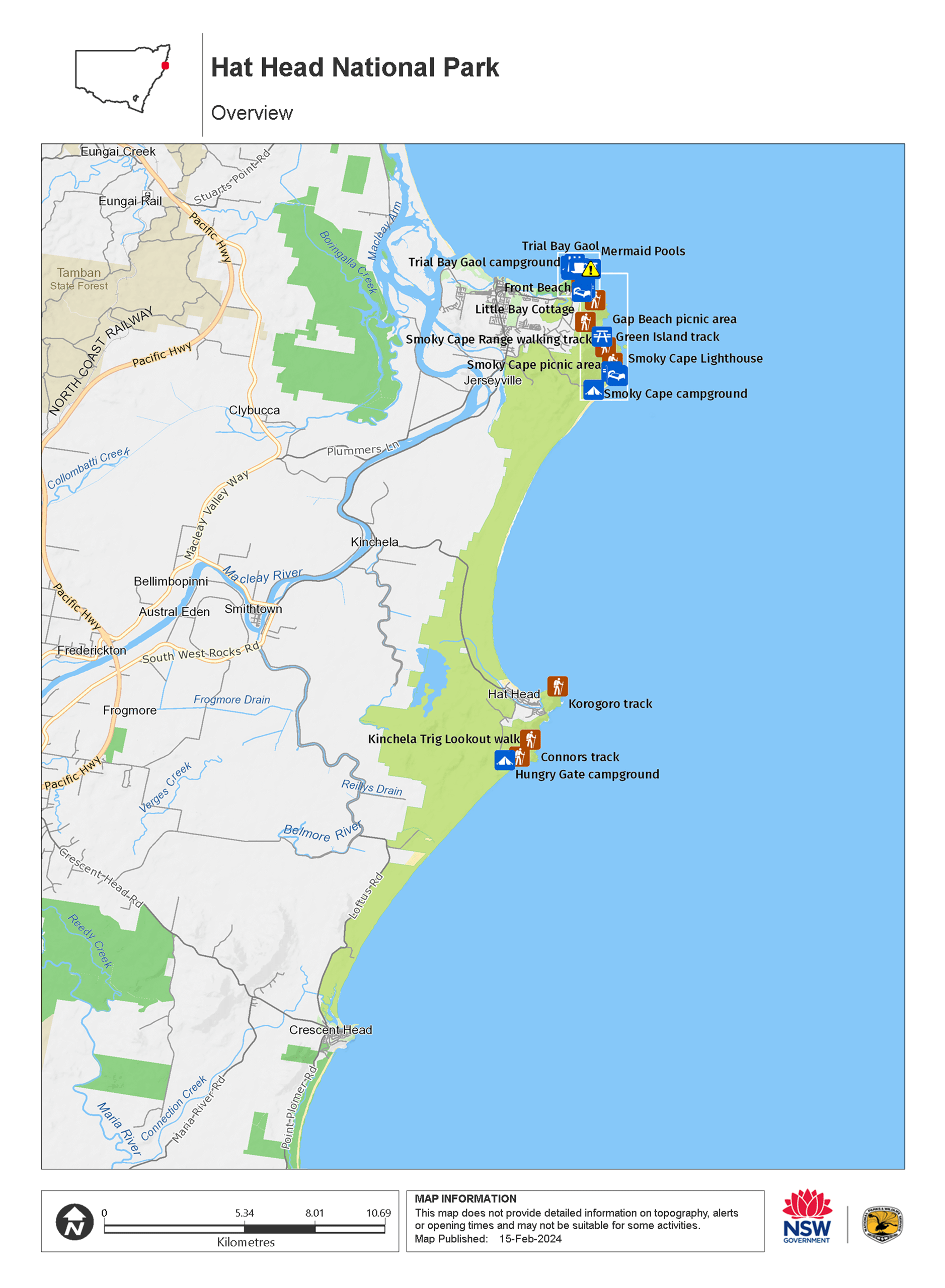
Map
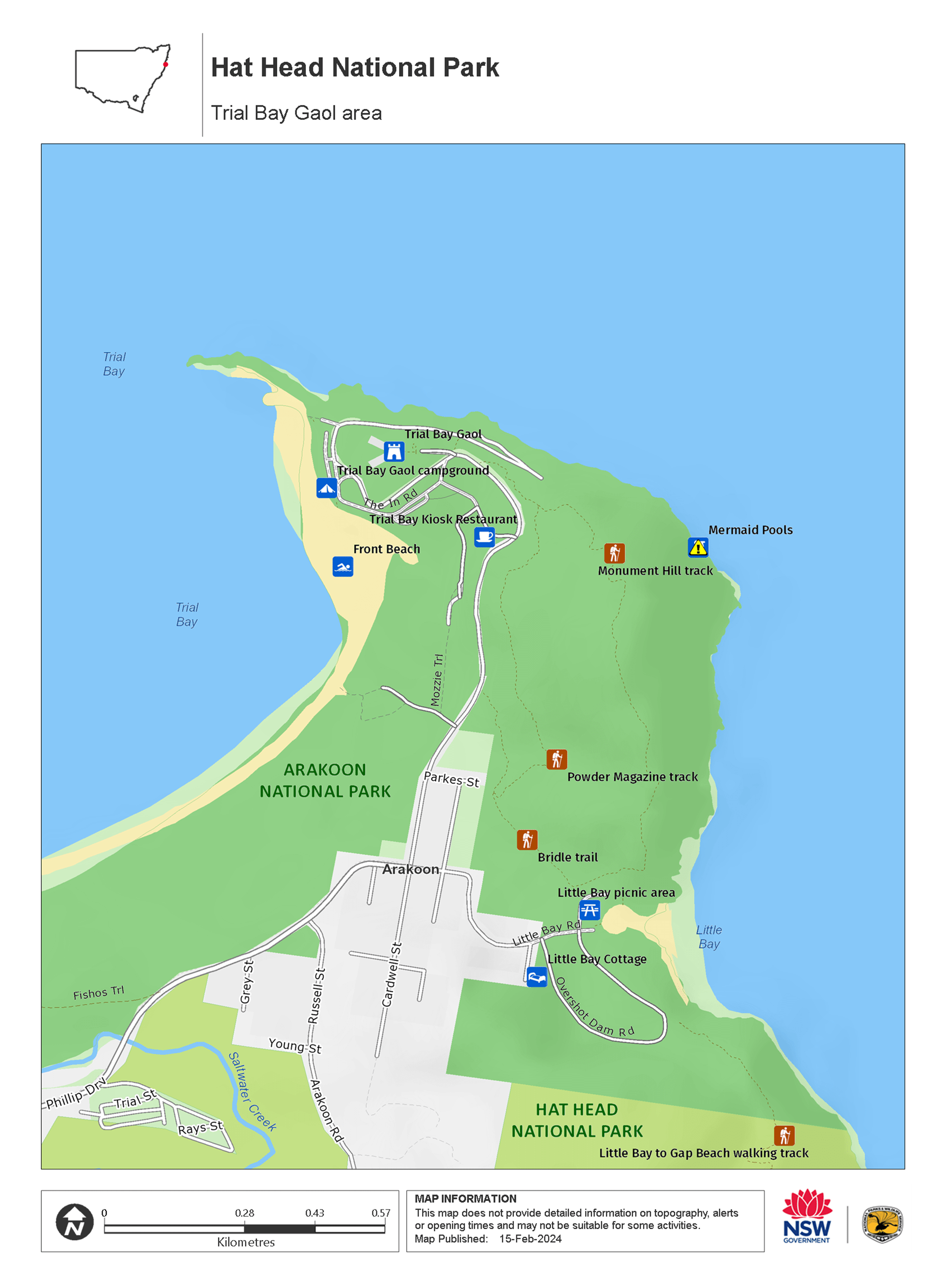
Map
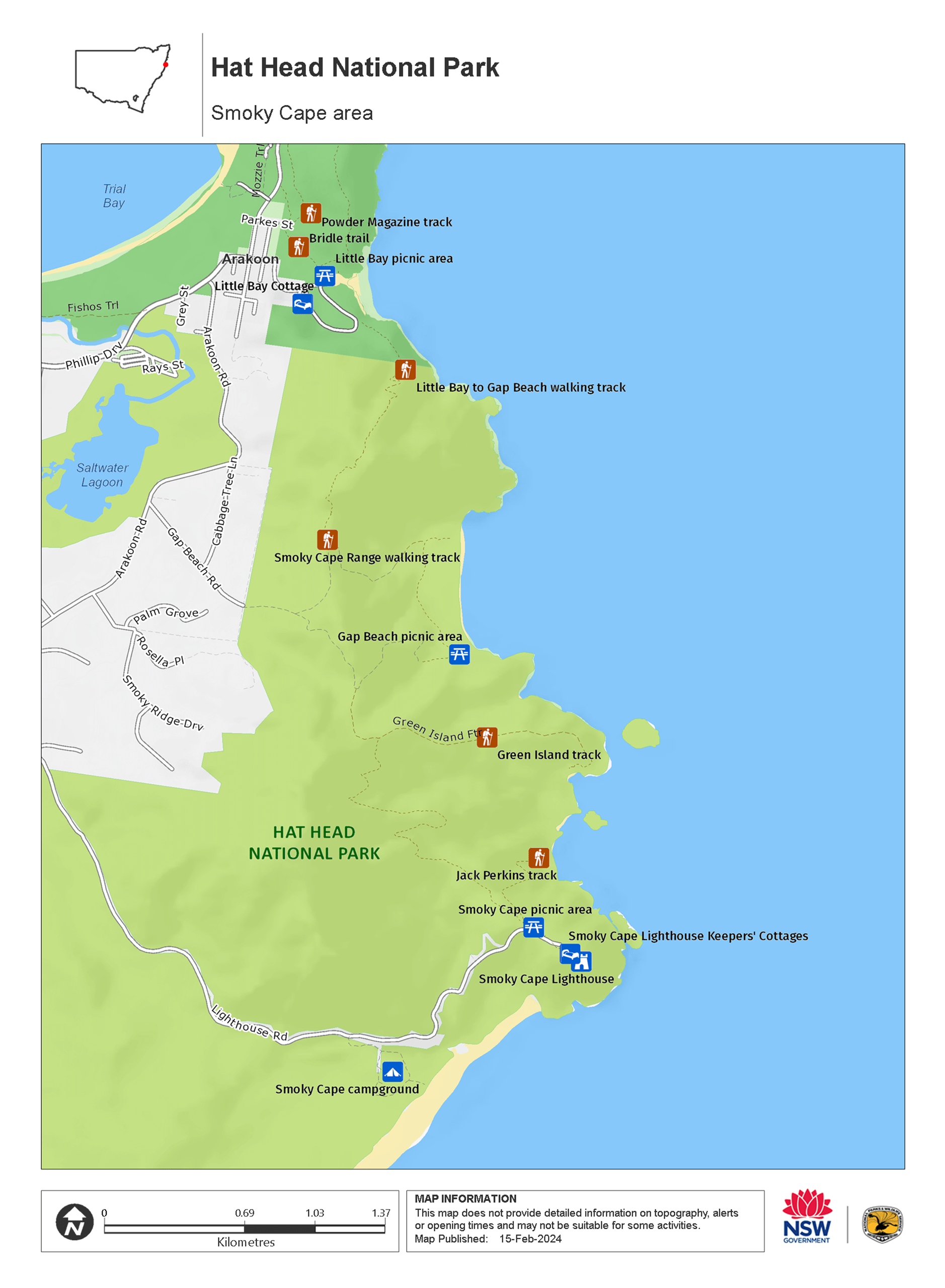
Map legend

Contact
- in the North Coast region
Hat Head National Park is always open but may have to close at times due to poor weather or fire danger.
-
Park entry fees:
$8 per vehicle per day.
Buy annual pass. -
-
Kempsey office
02 6561 6700
Contact hours: Monday to Friday, 9am to 4.30pm. - 247 Old Station Rd, Verges Creek NSW 2440
-
Email: npws.hastingsmacleay@environment.nsw.gov.au
-
Kempsey office
Visitor info
All the practical information you need to know about Hat Head National Park.
Getting there and parking
Get driving directions
From Kempsey:
- From the Pacific Highway take the South West Rocks Road to Kinchela.
- Follow the signs to Hat Head National Park
From Nambucca Heads:
- From the Pacific Highway take the South West Rocks Road via Gladstone
- Turn right onto the Hat Head Road at Kinchela and follow to the park
Road quality
- Unsealed roads
Vehicle access
- 2WD vehicles
By bike
Check out the Bicycle information for NSW for more information.
By public transport
For information about public transport options, visit the NSW country transport info website
Best times to visit
This park's sweeping beaches are extremely inviting during summer, but its wildlife and walking tracks make it a joy to visit all year round.
Spring
A birdwatcher's delight as the heath shrubland bursts into a kaleidoscope of wild flowers and birds come from all around, listen out for the guttural call of glossy black cockatoos.
Summer
Take a coastal bushwalk to experience wildflower displays amongst the banksias.
Winter
Spot humpback and southern right whales migrating to northern waters between May and July.
Weather, temperature and rainfall
Summer temperature
Average
19°C and 26°C
Highest recorded
41.7°C (1968)
Winter temperature
Average
13°C and 20°C
Lowest recorded
4°C (1997)
Rainfall
Wettest month
March
The area’s highest recorded rainfall in one day
343.7mm
Facilities
Toilets
- Green Island walking track
- Hungry Gate campground
- Little Bay to Gap Beach walking track
- Smoky Cape campground
- Smoky Cape picnic area
Picnic tables
- Green Island walking track
- Hungry Gate campground
- Little Bay to Gap Beach walking track
- Smoky Cape campground
- Smoky Cape picnic area
Barbecue facilities
Maps and downloads
Fees and passes
Park entry fees:
$8 per vehicle per day.
- All Parks Pass - For all parks in NSW (including Kosciuszko NP) $190 (1 year) / $335 (2 years)
- Multi Parks Pass - For all parks in NSW (except Kosciuszko) $65 (1 year) / $115 (2 years)
- Country Parks Pass - For all parks in Country NSW (except Kosciuszko) $45 (1 year) / $75 (2 years)
- Single Country Park Pass - For entry to a single park in country NSW (except Kosciuszko). $22 (1 year) / $40 (2 years)
Annual passes and entry fees (https://www.nationalparks.nsw.gov.au/passes-and-fees)
Prohibited
Pets
Pets and domestic animals (other than certified assistance animals) are not permitted. Find out which regional parks allow dog walking and see the pets in parks policy for more information.
Smoking
NSW national parks are no smoking areas.
Nearby towns
South West Rocks (5 km)
South West Rocks is a sleepy coastal retreat at its barefoot best. It's an oceanfront holiday town on north-facing Trial Bay.
Kempsey (32 km)
Kempsey is a historic river town close to national parks and majestic beaches. Kempsey is a convenient place for an overnight stop for anyone driving between Sydney and the North Coast.
Crescent Head (51 km)
Crescent Head on the NSW North Coast is surrounded by some of the stunning natural environments in the State. As well as long stretches of coastline with fabulous beaches, there is a string on coastal national parks to explore. Go surfing, fishing, boating and bushwalking, enjoy bird watching or whale watching, spot dolphins, turtles and even koalas in the wild.
Learn more
Hat Head National Park is a special place. Here are just some of the reasons why:
Striking landscapes
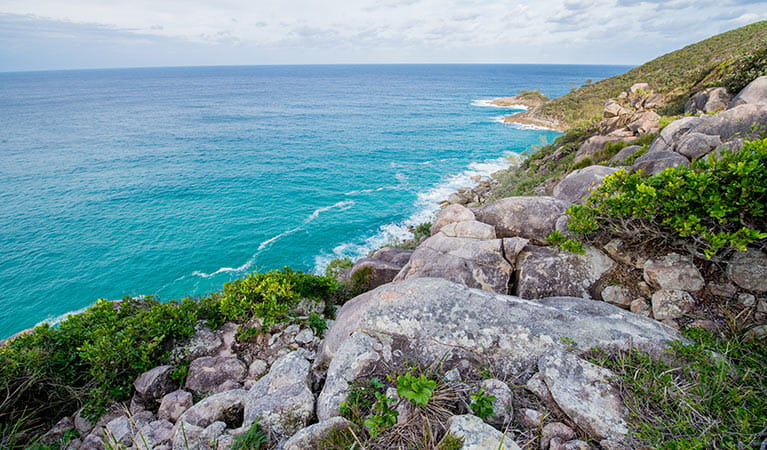
Some of the largest in New South Wales, the park's enormous sand dunes can't help but catch your eye. The dunes provide a buffer from the ocean, protecting the land from salty winds and waves. They are slowing growing and moving inland, gradually taking over the park's wetlands. See if you can make it to the top of the dunes - you'll get a bird's eye view and feel like you're on top of the world.
- Smoky Cape Lighthouse tour Walk alongside an NPWS ranger on an intimate tour of Smoky Cape lighthouse, the tallest lighthouse in NSW. Take in the stunning coastal scenery, in your own small group.
- Smoky Cape Range walking track Discover the beauty of the South West Rocks region on the Smoky Cape Range walking track. Hike this 5.5km coast walk and enjoy sensational views.
Biodiversity
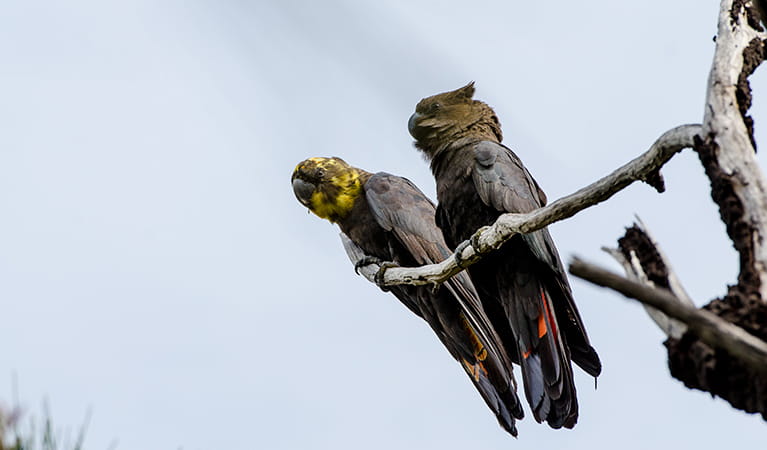
Hat Head National Park is rich with birdlife such as black swans, egrets, herons, fantails, and honeyeaters. If you’re lucky, you might even spot a hawk, falcon or eagle soaring above the cliffs. During the spring, you might catch a rare glimpse of a glossy black cockatoo - listen out for the raucous call of this endangered species as it visits the park to feed on ripe she-oak fruit seeds. Resident wildlife at Hat Head includes red-necked and swamp wallabies as well as grey kangaroos and sugar gliders. You're bound to see butterflies fluttering past you in Hat Head National Park. One type, the regent skipper, is only found in Hat Head National Park and Limeburners Creek National Park. With black wings and a range of yellow and red dots and stripes, you might see the regent skipper feeding on tuckeroos in the park's rainforest.
- Little Bay to Gap Beach walking track Little Bay to Gap Beach walking track is a challenging walk offering birdwatching, swimming, fishing and scenic views in Hat Head National Park, near South West Rocks.
A place to play
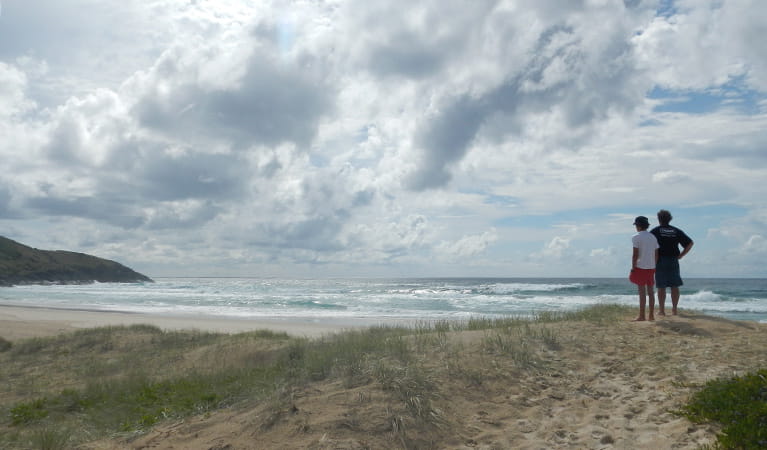
Hat Head National Park protects an extraordinary amount of landscapes, birds and animals, but also offers countless opportunities for secluded relaxation, recreation and enjoyment. Sweeping beaches, rainforests, impressive dunes, and rocky headlands make it the perfect holiday or day trip for walking, swimming, hiking, bird watching and fishing.
- Green Island walking track Green Island walking track goes through coastal heathland to a lookout with scenic views to Smoky Cape Lighthouse, offering excellent birdwatching and whale watching.
- Smoky Cape Lighthouse Hat Head National Park on the mid-north coast of NSW near South West Rocks is a natural paradise. Explore the lighthouse, camp by the beach and go fishing and swimming.
A long story to tell
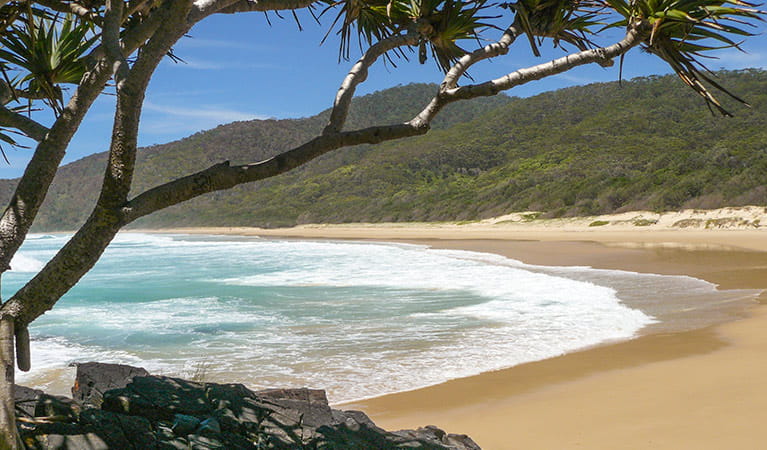
The park is part of the traditional land of the Dunghutti people and remains a significant place. The sea, rivers and wetlands provided a rich source of food like fish and shellfish and the strong Aboriginal heritage is evident today. The park is culturally important to Aboriginal people as it contains ceremonial grounds, burial sites, shell middens and campsites.
Plants and animals protected in this park
Animals
-

White-bellied sea eagle (Haliaeetus leucogaster)
White-bellied sea eagles can be easily identified by their white tail and dark grey wings. These raptors are often spotted cruising the coastal breezes throughout Australia, and make for some scenic bird watching. Powerful Australian birds of prey, they are known to mate for life, and return each year to the same nest to breed.
-
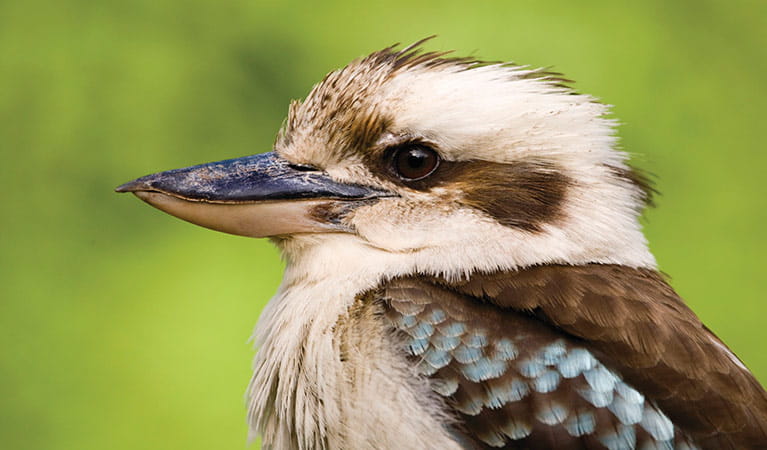
Kookaburra (Dacelo novaeguineae)
Of the 2 species of kookaburra found in Australia, the laughing kookaburra is the best-known and the largest of the native kingfishers. With its distinctive riotous call, the laughing kookaburra is commonly heard in open woodlands and forests throughout NSW national parks, making these ideal spots for bird watching.
-
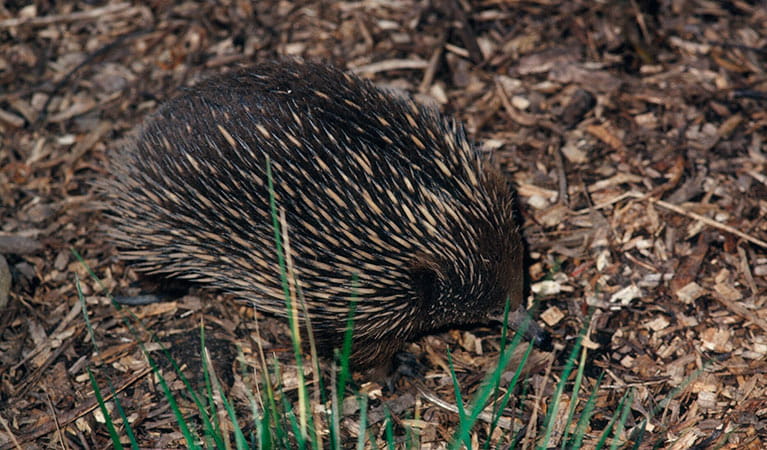
Short-beaked echidna (Tachyglossus aculeatus)
One of only 2 egg-laying mammals in the world, the short-beaked echidna is one of the most widespread of Australian native animals. Covered in spines, or quills, they’re equipped with a keen sense of smell and a tube-like snout which they use to break apart termite mounds in search of ants.
Plants
-
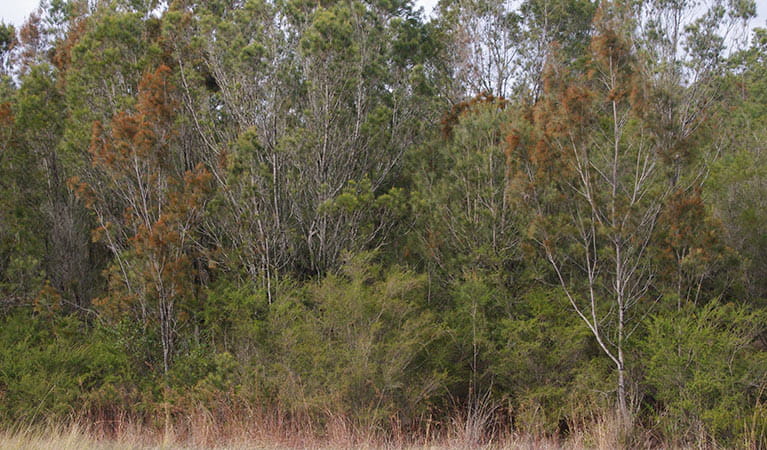
Black sheoak (Allocasuarina littoralis)
The black sheoak is one of a number of casuarina species found across the east coast of Australia and nearby tablelands. Growing to a height of 5-15m, these hardy Australian native plants can survive in poor or sandy soils. The barrel-shaped cone of the black sheoak grows to 10-30mm long.
-

Grass tree (Xanthorrea spp.)
An iconic part of the Australian landscape, the grass tree is widespread across eastern NSW. These Australian native plants have a thick fire-blackened trunk and long spiked leaves. They are found in heath and open forests across eastern NSW. The grass tree grows 1-5m in height and produces striking white-flowered spikes which grow up to 1m long.
Environments in this park
Education resources (1)
What we're doing
Hat Head National Park has management strategies in place to protect and conserve the values of this park. Visit the OEH website for detailed park and fire management documents. Here is just some of the work we’re doing to conserve these values:
Understanding landscapes and geology
NPWS is dedicated to preserving the special landscapes and natural assets of Hat Head National Park. Programs to protect rivers, wetlands and coastal environments are in place within the park.
Preserving biodiversity
Biodiversity is integral to Hat Head National Park, and efforts to preserve this are ongoing. Bush regeneration, maintaining the landscape and upgrades to infrastructure are regularly carried out in the park. Displaying up-to-date, easily understandable signage is also an ongoing priority in this park.
Managing weeds, pest animals and other threats
Pests and weeds have a significant impact on the ecosystems within Hat Head National Park. Pest reduction of introduced species, such as wild dogs, as well as risk assessment for new and emerging weeds, is an important part of the work NPWS does to protect the biodiversity values of this park.
Developing visitor facilities and experiences
Hat Head National Park is committed to providing safe, top-quality facilities for visitors to enjoy. Maintenance is frequently carried out on the park’s walking tracks.
Conserving our Aboriginal culture
Hat Head National Park places great value on the region’s Aboriginal legacy, and works to combine conservation efforts with dynamic visitor education initiatives. Aboriginal cultural heritage programs are carried out in this park.
Managing fire
NSW is one of the most bushfire prone areas in the world as a result of our climate, weather systems, vegetation and the rugged terrain. NPWS is committed to maintaining natural and cultural heritage values and minimising the likelihood and impact of bushfires via a strategic program of fire research, fire planning, hazard reduction, highly trained rapid response firefighting crews and community alerts.

